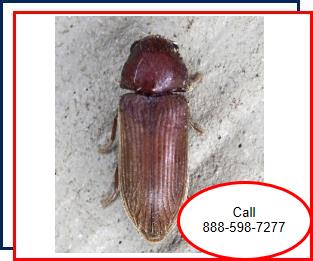Powderpost Beetles
PROFESSIONAL POWDERPOST BEETLE CONTROL- NASSAU COUNTY, NEW YORK
Powderpost beetle is a term used to refer to a wide variety of woodboring beetles, including true powderpost beetles (Lyctinae), anobiid powderpost beetles (Anobiinae), and false powderpost beetles (Bostrichidae). Powderpost beetles are second to termites in their ability to damage seasoned wood. The larvae of powderpost beetles feed on wood, reducing it to a mass of fine powder called frass. Powderpost beetles attack deciduous trees and anything made of deciduous wood. Anobiid powderpost beetles infest seasoned softwoods and the sapwood of seasoned hardwoods. True powderpost beetles infest the sapwood of hardwoods, primarily oak, hickory, ash, maple, walnut, pecan, poplar, cherry, myrtle, and mahogany. False powderpost beetles, also known as auger and horned powderpost beetles, infest the sapwood of seasoned hardwoods and, occasionally, softwoods. Powderpost beetles are frequently introduced into homes via wooden materials that are brought in, including wooden furniture, building materials, and firewood. Homeowners are more likely to see the damage done by powderpost beetles than the beetles themselves. The surface of wood infested with powderpost beetles is perforated with numerous holes about the size of a pencil lead. The severity of the damage caused by powderpost beetles is contingent upon several factors, including the species of powderpost beetle, moisture content and age of the wood, and temperature and relative humidity.
THE ANATOMY OF A POWDERPOST BEETLE


Powderpost beetles have a hard exoskeleton, including the forewings called elytra, which serve to protect their hindwings.
Powderpost beetle bodies are divided into three sections: head, thorax, and abdomen.
Powderpost beetles have two compound eyes, two antennae, and three pairs of legs.
Powderpost beetles have abdominal spiracles through which they breathe air.
Powderpost beetles have a pronotum which is located directly behind their head.
Powderpost beetles have a scutellum, a triangular structure located between their forewings and behind the pronotum.
POWDERPOST BEETLE LIFE CYCLE
Powderpost beetles are insects that undergo complete metamorphosis, which consists of four stages: the egg, larva, pupa, and adult. Female powderpost beetles lay their eggs on wood, and larvae hatch from the eggs. Larvae tunnel into the wood and begin feeding and, at maturity, burrow toward the surface and pupate. Adult powderpost beetles emerge from the pupa and tunnel through the surface. The newly emergent adults exit the wood to mate, lay eggs, and repeat the cycle. The time required for the powderpost beetle larvae to complete their development varies from a few months to several years. Larvae development time is dependent upon the beetle species and the availability of food and moisture content of the wood.

TYPES OF POWDERPOST BEETLES - LONG ISLAND, NEW YORK
•Lyctid powderpost beetles - These beetles are reddish-brown to black in color. Lyctid powderpost beetles have elongated, slender, flattened bodies about 1/4" in length, and their heads are prominent and project forward.
•Bostrichid powderpost beetles - These beetles are reddish-brown to black in color. Bostrichid powderpost beetles have slender cylindrical bodies about 1/4" in length, with a roughened thorax, and their heads are oriented downwards, making them appear hooded. They have a segment behind their heads that often bears numerous short spines producing a rasplike appearance.
•Anobiid powderpost beetles - These beetles are reddish to dark brown in color. Anobiid powderpost beetles have slender cylindrical bodies about 1/4" in length, are covered with fine hair, and their heads are oriented downwards.
POWDERPOST BEETLE PREVENTION LONG ISLAND, NEW YORK
Powderpost beetle infestations frequently result from improperly dried or stored wood containing beetle eggs or larvae being introduced into the home. Wood that has not been kiln-dried or adequately stored should not be used, particularly if powderpost beetle exit holes are present. Powderpost beetles lay their eggs on unfinished wood. Bare wood can be protected from powderpost beetle infestations by painting, waxing, varnishing, or finishing exposed surfaces. Powderpost beetles have specific moisture requirements for development and survival. Increasing ventilation and installing a moisture or vapor barrier in a crawl space will reduce the wood moisture content and eliminate the threat of an infestation by anobiid powderpost beetles.
HOW TO GET RID OF POWDERPOST BEETLES - NASSAU COUNTY, NY
Controlling Powderpost beetles is a multi-step process. Getting rid of a powderpost beetle infestation at a Long Island residence or business can be complicated, even for the most experienced powderpost beetle exterminator. In the absence of the proper training, equipment, and restricted use pesticides, eradicating an infestation of powderpost beetles from your Nassau County, Long Island home, or place of business is an endeavor that will fail. Therefore, you need to contact the Long Island powderpost beetle control professionals at Nassau County Pest Control. Our Long Island powderpost beetle exterminating experts have an extensive knowledge of powderpost beetle control methods and many years of experience combating powderpost beetle infestations.
